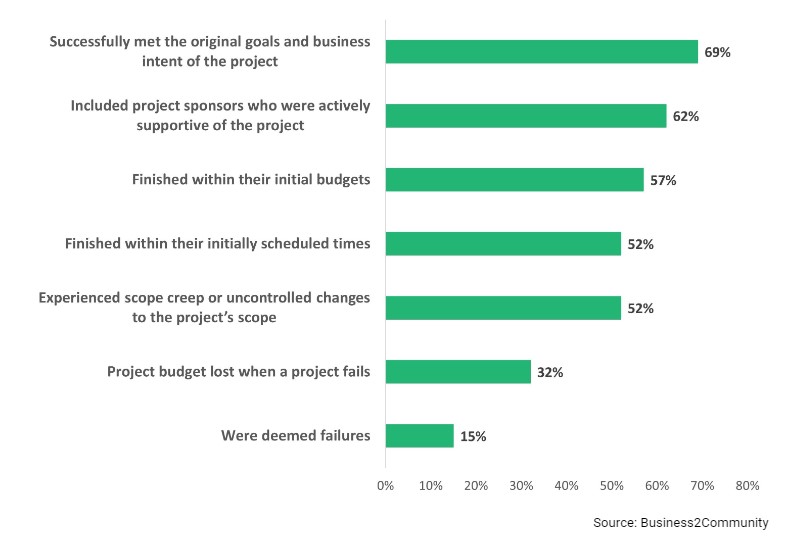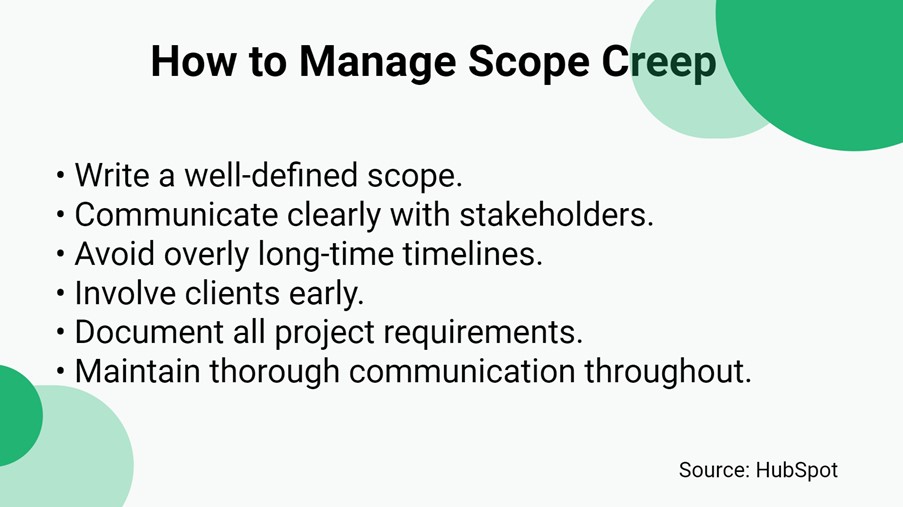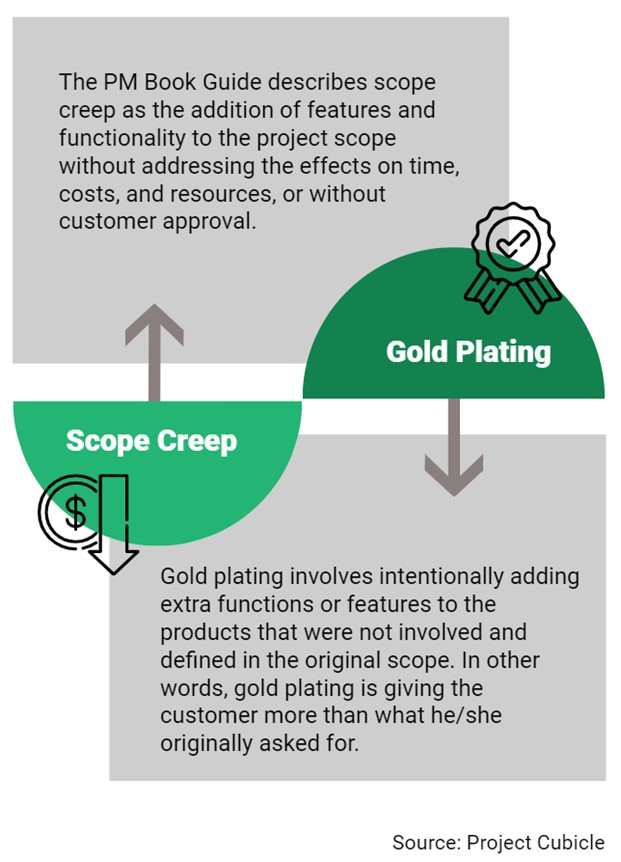
Isn’t it surprising how project management scope creep continues to derail even the most meticulously planned modern projects? Many technology projects fail to meet expectations, resulting in substantial losses for the companies that initiate them. The data is alarming: Gartner estimates that 55% to 75% of ERP projects are unsuccessful, and McKinsey reveals that 70% of digital transformation efforts do not achieve their objectives. Most projects face the same challenges, and their complexity and interdepartmental scope make them especially vulnerable to failure. This article elucidates the concept of project management scope creep, provides illustrative instances, offers guidance on preventative measures, and suggests modern technology solutions for instances where scope creep has already reached an unmanageable state.
What is Project Management Scope Creep?
Every project starts with agreed-upon project prerequisites, including timeline, budget, boundaries, and deliverables. Project management scope creep happens when requirements go beyond the initial plan without approval or control. It may result from extra features, funding, resources, or personnel needed for the project. Project management scope (or “requirement creep” or “feature creep”) means project requirements increase over time. For example, one deliverable becomes five; a product with three features needs ten; or a customer needs changes mid-project, requiring new project requirements.
Project management scope creep is often caused by stakeholders changing requirements or internal miscommunication and conflicts. This article covers how project management scope affects projects and how to stop it early. While it can cause delays, challenges, or budget issues, project management scope is not always bad. Change is inevitable—customer needs change over time, and projects must adapt to meet them. Therefore, project management scope creep is something every good project manager expects and plans for.
Unfortunately, scope creep poses a significant risk to the majority of projects. As per the 2018 Pulse of the Profession survey by PMI, project management scope creep was experienced in 52% of projects. Even among the top performers identified by PMI, one-third of the projects encountered some degree of scope creep.
In your estimation, what percentage of projects were completed
within your organization in the past 12 months?

Common Causes of Project Management Scope Creep (and How to Address Them)
Project management scope creep can manifest for various reasons, but some prevalent factors include poorly defined scope requirements, an excess of decision-makers, an inadequate change control process, deficient task prioritization, and unregulated client requests. Here's an overview of these challenges and strategies to mitigate them:
- Poorly Defined Project Scope Requirements - Stakeholders cannot adhere to an undefined scope. To combat this, create a comprehensive document outlining project requirements, encompassing budget, resources, goals, tasks, deliverables, and timelines. Employ visual aids like charts and diagrams for clarity, and present this document to all stakeholders, including implementers and project stakeholders.
- Too Many Decision-Makers - When all stakeholders act as decision-makers, scope approval can become chaotic with conflicting plans and change requests. To avoid this, establish clear roles in your change management plan. Define the final decision-maker, those with scope change approval authority, those for consultation, and those for notification.
- Lack of Task Prioritization - Some projects could become overly lengthy and expensive if all desirable tasks and features were included. It's crucial to strike a balance between final deliverable quality and constraints. This can be achieved through task prioritization. Engage stakeholders to identify critical tasks and optional ones. Use this prioritization to cut superfluous tasks if project management scope creep threatens the project.
- Poor or Missing Change Control Process - A well-structured change control plan is essential. It defines the scope change request process and authorizations. It also ensures that scope change requests are comprehensive to prevent uncontrolled growth post-approval. All stakeholders and project implementers must understand this document to prevent uncontrolled changes.
- Unregulated Client Requests - Clients often make numerous requests to maximize their investment. To manage this effectively, ensure your project team knows who can approve change requests, the approval parameters, and how to decline client requests without damaging the relationship. Establish a change control plan and provide thorough training to manage client requests more effectively.

Modern AI solutions offer promising avenues to mitigate project management scope creep by leveraging predictive analytics, automation, and intelligent decision-making algorithms. These solutions can analyze historical project data, current progress, and various contextual factors to anticipate potential scope changes accurately. By employing machine learning models, they can forecast deviations from the initial project scope and identify early warning signs of scope creep.
Real-World Project Management Scope Creep Examples
Notable use cases of project management scope creep serve as instructive examples:
- Company: Apple Inc. - Project: Development of the iPhone X
Scope Creep: Initially planned as a sleek smartphone, additional features such as facial recognition technology and augmented reality capabilities were integrated during the project, leading to an expansion of the project scope. - Company: Tesla, Inc. - Project: Model 3 Production
Scope Creep: Tesla's ambitious goal to produce affordable electric cars saw scope creep as the company continuously introduced new features and modifications, contributing to delays and increased project complexity. - Company: Amazon - Project: Amazon Prime Delivery Drones
Scope Creep: The introduction of additional capabilities, such as increased payload capacity and extended delivery range, expanded the initial scope of the drone delivery project, resulting in delays and unforeseen challenges.
Likewise, numerous projects across industries are impacted by scope variations and unforeseen change requests. To this end, AI-powered project management tools can streamline communication channels, facilitate real-time collaboration, and provide instant alerts to project stakeholders when scope changes occur. Through intelligent automation, these solutions can optimize resource allocation, prioritize tasks, and suggest adaptive strategies to keep projects aligned with their original objectives. By harnessing the power of AI, project managers can proactively address scope creep, enhancing project efficiency, reducing risks, and ensuring successful project delivery.
8 Essential Tips for Preventing Scope Creep
In the world of project management, preventing project management scope creep is paramount for successful project delivery. Here, we present seven valuable tips to help you stay on course and maintain control over your project's scope:
- Define Project Scope Upfront - Before embarking on a project, it's crucial to establish a clear and comprehensive scope. Many projects falter due to a lack of well-defined scope. Define the scope with input from your change control board, stakeholders, and clients, and ensure you have a baseline scope in place before the project commences.
- Document Scope Changes - Scope changes are inevitable, but it's essential to document them rigorously. Each change should be documented, evaluated, and assessed for its impact on the project. The change control board should play a pivotal role in approving or rejecting scope changes, ensuring that they align with project objectives.
- Re-baseline Your Project Schedule or Project Plan - When scope changes are approved, it's imperative to re-baseline your project schedule or plan accordingly. Neglecting this step is a common pitfall that leads to project failure. Re-baselining after scope changes ensures that your project remains aligned with its goals and objectives.
- Request Additional Funding or Resources - After scope changes are approved, don't hesitate to request the necessary funding and resources to implement these changes effectively. Without adequate support, even approved changes can lead to project disruptions and ultimately result in scope creep.
- Communicate with Your Project Team and Track Progress - Effective project management involves staying vigilant and keeping a close eye on your project team's progress. Be aware of subtle signs that things may not be going as planned. Encourage open communication within your team to ensure that scope changes are not slipping through unnoticed.
- Set Priorities - In situations where multiple stakeholders bring forth scope changes, setting priorities is essential. Establish a change control board to evaluate and prioritize these changes. This approach prevents conflicting demands from different groups and ensures that the most critical changes are addressed.
- Avoid Scope Creep Traps - Project management scope creep often starts with seemingly innocent phrases like "while you're in there" or "it won't take that long." These traps can lead to uncontrolled scope expansion. It's crucial to scrutinize proposed changes rigorously, assess their feasibility, and base decisions on thorough evaluation rather than hasty assumptions.
- Adopt AI Solution - AI offers unparalleled capabilities to unlock insights from vast volumes of data, enabling projects to make data-driven decisions swiftly and accurately. By automating repetitive tasks and augmenting human capabilities, AI enhances productivity and efficiency across various business functions. Moreover, AI-powered predictive analytics empowers projects to anticipate progress trends, stakeholder preferences, and potential risks, enabling proactive strategic planning.
By following these tips, you can fortify your project management scope creep approach and significantly reduce the risk of scope creep, increasing the likelihood of a successful project outcome.

How to Manage Complex Project Management Scope Creep
Effectively addressing project management scope creep that has escalated beyond control is undeniably a challenging task, yet it remains within the realm of achievability. Here are steps you can take to regain control and mitigate the damage caused by severe scope creep:
- Assess the Current Situation - Begin by conducting a thorough assessment of the project. Document all the changes and additional requirements that have led to project management scope creep. Identify the impact of these changes on the project timeline, budget, and overall goals. This assessment will help you understand the extent of the issue and what needs to be addressed.
- Engage Key Stakeholders - Assemble a team of key stakeholders, including project sponsors, clients, and those responsible for implementing changes. Openly discuss the current situation, emphasizing the negative consequences of project management scope creep, such as project delays, budget overruns, and potential failure. Encourage honest and transparent communication to ensure everyone understands the gravity of the situation.
- Prioritize and Evaluate - With your team of stakeholders, prioritize the changes and additional requirements. Identify which are critical to the project's success and which can be deferred or discarded. This step is essential to ensure that you focus on resolving the most crucial issues first.
- Rebaseline the Project - Once you've established the priorities, reestablish a new baseline for your project. This baseline should incorporate the approved changes and requirements, reflecting the project's new scope. Ensure that this rebaselining is comprehensive and covers all aspects, including the schedule, budget, and deliverables.
- Resource Reallocation - Assess the resource requirements to implement the approved changes. If additional resources are necessary, work with your stakeholders to allocate them appropriately. Be prepared to adjust your resource plan to accommodate the scope changes.
- Communication Plan - Develop a robust communication plan to keep all project team members informed about the scope changes and their implications. Clearly define roles and responsibilities, so everyone understands their part in managing project management scope creep.
- Strict Change Control - Implement a rigorous change control process to ensure that any further changes to the project scope are well documented, evaluated, and approved by the change control board. Define the criteria that will be used to assess future change requests, and make sure everyone adheres to these guidelines.
- Risk Mitigation - Identify potential risks associated with the remaining project management scope creep and develop mitigation strategies. This may include setting aside contingency reserves for unexpected scope changes or adopting a more agile approach to handle evolving requirements.
- Regular Monitoring and Reporting - Establish a system for continuous monitoring and reporting on project progress. Regularly update your stakeholders on the status of the project, any new scope changes, and the impact on the schedule and budget.
- Lessons Learned - Finally, after successfully navigating project management scope creep and completing the project, conduct a thorough "lessons learned" session. Document what went wrong and what could have been done differently to avoid project management scope creep.
Use these insights to improve your project management processes for future endeavors.

While managing unmanageable project scope creep is undoubtedly a complex and demanding process, taking these proactive steps can help you regain control over your project and steer it toward a successful outcome.
Moreover, AI solutions streamline project management processes by automating routine tasks, facilitating real-time collaboration among team members, and providing actionable insights for informed decision-making. By harnessing AI technologies for project tracking, businesses can enhance productivity, minimize costs, and ensure the successful delivery of projects within budget and timelines, ultimately driving long-term success and growth.
Conclusion
Project management scope creep, often a formidable challenge in technology projects, subtly erodes the likelihood of success and inflicts significant losses. It manifests in various forms, from elusive objectives to a chaotic array of conflicting plans and change requests. This article discusses comprehensive steps to combat this threat, encompassing meticulous documentation of project requirements, implementation of change control processes, formulation of a well-defined project schedule, alignment of scope with stakeholder expectations, and active engagement of the project team. These measures collectively form a robust defense against project management scope creep, steering your projects toward success.
In the era of predictive intelligence and advanced technology, it's more crucial than ever to shield your projects from the lurking danger of project management scope creep. By harnessing state-of-the-art solutions, you can ensure your project stays on course and within scope.
TrueProject, with its robust features, can significantly mitigate project management scope creep. It enables clear definition of project objectives, ensuring all stakeholders have a unified understanding of the project’s scope. By facilitating effective communication and change management, TrueProject helps maintain focus on the original goals. Furthermore, it provides tools for tracking project progress and changes, allowing for timely identification and management of potential scope creep. Thus, TrueProject is a valuable ally in maintaining project integrity and success. Eliminate the risks of project management scope creep and embrace successful project delivery with TrueProject by your side.
More information on TrueProject at trueprojectinsight.com
Endnotes
- Wrike Team Content. “What Is Scope Creep in Project Management?” Wrike: (n.d.) https://www.wrike.com/project-management-guide/faq/what-is-scope-creep-in-project-management/
- Kajal. “What is Scope Creep in Project Management and its Causes?” Unichrone: February 02, 2022. https://unichrone.com/blog/project-management/what-is-scope-creep-in-project-management/
- William Malsam. “What Is Scope Creep and How Can I Avoid It?” ProjectManager: May 26, 2021. https://www.projectmanager.com/blog/5-ways-to-avoid-scope-creep
- Alana Rudder, Kelly Main. “Scope Creep: Definition, Examples & How To Prevent It.” Forbes: August 25, 2022. https://www.forbes.com/advisor/business/scope-creep/
- Alana Rudder, Cassie Bottorff. “What Is A Project Management Plan And How To Create One”
- Forbes: August 01, 2023. https://www.forbes.com/advisor/business/project-management-plan/
- Kathy Castle. “Scope Creep vs Gold Plating in Project Management.” Project Cubicle: Feb 13, 2018. https://www.projectcubicle.com/scope-creep-and-gold-plating/






